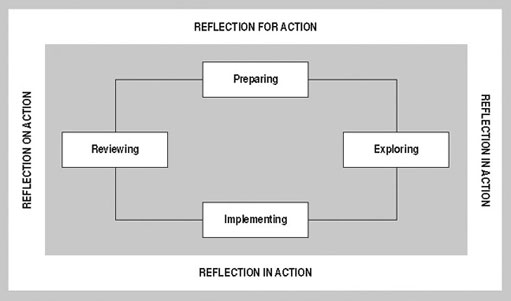9 Learning how to become a reflective learner
9.1 Reflection and the four main phases of learning how to learn
If your course encourages this approach to learning, or if you have read other material on learning how to learn, you may have come across the term 'reflection'. Maybe you have been encouraged to reflect on your learning or on your assignments. In this course, we have deliberately not used the term until now. This is not because we think the term - or the process - is unimportant, but because it can seem vague and not particularly helpful to you as a learner. In fact, all the activities in this course have involved reflection of some kind. In this final section, we want to explore the meaning of the term and explain how it can help you in learning how to learn (Figure 5).
The preparation phase involves you in looking back as well as looking forward before embarking on a section of study within a course or perhaps the course as a whole. It encourages you to pause and think purposefully before moving on and has been described as reflection-for-action.
The over-arching emphasis of both the exploring and implementing phases is of being aware of what you are doing while you are doing it - often described as reflection-in-action. Such reflection needs to be critical reflection - asking yourself questions, checking your thoughts and actions, explaining to yourself (or others) why you are saying, writing, or doing things in this way. Reflection in action is difficult but becomes easier when carried out with another person who can listen to you talking through your work or reading what you have written.
The final reviewing phase closes the cycle; it overlaps with and leads into preparation for the next section of learning and assessment, or perhaps to revision and exams. This is a time for reflection-on-action to conclude the process. Look back over the whole learning experience and identify what you have learned from studying this part of the course and completing the assignment. The emphasis should be on both the content learned and how you learned it - this is the meaning of learning how to learn.
Courses are often very demanding in terms of time and some are overloaded. You may be tempted, especially in your first year, to struggle on, preoccupied with trying to keep up. It is hard to make yourself pause and consider how you are studying and learning even when course materials invite you to do so. In most courses there are natural breaks - at the end of a course or block of study as well as after the completion of an assignment. These are designed to help you fit in time for reflection-on-action, a conclusion for the section of work you have just completed and a preparation for starting the cycle again with the next section of your coursework.

